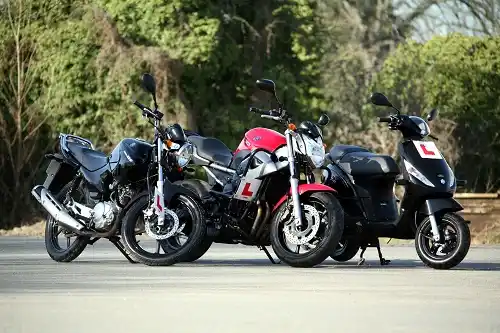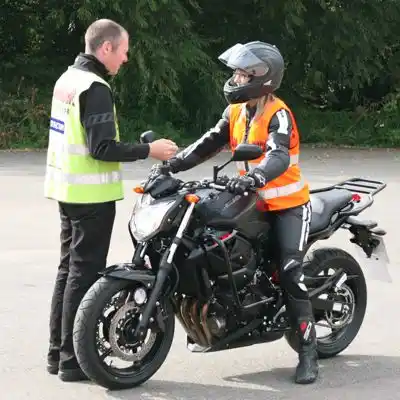Book motorbike training in Thornton Cleveleys, Lancashire with any of the companies listed here
Click on any of the motorcycle training schools below to view more information and check availability.
Raceways Rider Training Lancashire
48-60 Dock Street, Fleetwood, Lancashire, FY7 6AG
Approx. distance: 3.5 miles
Riverview Rider Training Preston
Rimington, Guide Road, Hesketh Bank, Preston, Lancashire, PR4 6XS
Approx. distance: 13.2 miles
Real Rider Motorcycle Training Barrow in Furness
Vickerstown Foolball Club, Mill Lane, Barrow in Furness, LA14 3NN
Approx. distance: 19.2 miles
RIDE Motorcycle Training Carnforth
Unit 11F, Keer Park, Carnforth, Lancashire, LA5 9FG
Approx. distance: 20.6 miles
RJH Motorbike Training Ltd Chorley
Yamaha Centre, Eaves Lane, Chorley, Lancashire, PR6 0TB
Approx. distance: 22.4 miles
West Pennine Motorcycle Training Blackburn
West Pennine Road Safety Centre, Blackburn, Lancashire, BB1 3ES
Approx. distance: 24.5 miles
Hens and Chickens Rider Training at Almaxx Liverpool
Hen & Chicken Garage, Liverpool, Merseyside, L31 1AN
Approx. distance: 25.3 miles
RJH Motorbike Training Ltd Wigan
Yamaha Centre, Wilcock Street, Wigan, WN3 4AR
Approx. distance: 27.7 miles
Bikesmart Motorcycle Training Wigan
Rosebridge Court, Rosebridge Way, Ince-in-Makerfield, Wigan, Greater Manchester, WN1 3DP
Approx. distance: 28.4 miles
Phoenix Motorcycle Training Wigan
3 Sisters Circuit, Ashton-In-Makerfield, Wigan, Lancashire, WN4 8DD
Approx. distance: 30.2 miles

Have you been hunting for motorbike training in Thornton Cleveleys, Lancashire?
Have you been on the hunt for a company that can help you organise motorbike training in Thornton Cleveleys or nearby in Thornton, Cleveleys and Poulton le Fylde? Whilst price is important, the most important factor is the quality of motorcycle training. Book CBT Now has the largest listing of all motorcycle training companies in the UK. Simply enter your postcode and we will show you all of your local training companies that run motorcycle training and testing.
What are the different types of motorcycle licence I can get in Thornton Cleveleys?
There are 4 main types of full motorcycle licence issued by the DVSA. The first three (AM, A1 and A2 motorcycle licences) have restrictions on the type of moped or motorcycle you can ride, the fourth (the full A motorcycle licence) has no restrictions.
The AM restricted moped licence
The A1 restricted motorcycle licence
The minimum age to take this test is 17. According to the DVSA website it will allow you to ride a "Light motorcycle up to 11 kW (and a power-to-weight ratio not more than 0.1 kW per kg) and 125 cc". This means it's up to a 125 cc motorcycle with some restrictions to make sure it cannot accelerate too fast - a really good idea when you are new to riding a motorbike!
Requirements to take the A1 motorcycle test - You must have a UK provisional or full driving licence, a valid theory test certificate and a valid CBT certificate. Once you have taken this test you will not have to keep renewing your CBT certificate every 2 years, you can ride on motorways and you can take a pillion passenger on the back of your motorbike.
The A2 restricted motorcycle licence
For this licence you need to be at least 19 years of age, have completed your CBT or have had an A1 licence for at least 2 years. As with the A1 test you also need to have a UK provisional or full driving licence and a valid theory test certificate . The main benefit of getting an A2 licence is you can ride a more powerful motorcycle. The law states a "standard motorcycle up to 35 kW (and a power-to-weight ratio not more than 0.2 kW per kg)". So it's a more powerful bike, but still not completely un-restricted. To find A2 legal motorbikes you are best visiting your local motorcycle dealer and asking them to show you the A2 legal bikes, as otherwise it's very difficult to work out just looking at the tech specs.
The full A motorcycle licence, or DAS licence.
This is the licence that allows you to ride almost any motorcycle without restrictions, so it's the ultimate motorcycle licence. No limits on power outputs or power per kg or engine size! It is also called a 'DAS' licence as it can be obtained from the 'Direct AccesS' route. There are two ways you can get this licence:
1) If you are 24 or over you can take the tests for an A licence. You must also have a UK provisional or full driving licence, a valid theory test certificate and a valid CBT certificate.
2) If you are at least 21 years of age and you have held an A2 category licence for at least 2 years. This is sometimes referred to as the 'progressive access' route as you progress from one licence to another.
When taking the test the biggest difference is that you have to use a bigger, more powerful motorcycle. It will have a power of at least 40kw and an engine cc of at least 595 cc. Your local training school will make sure you have the right size bike for your test.
There is also a flowchart (click here) that the DVLA have produced that shows these different licences and how to obtain them.
To get more detailed guidance on what licence is right for you then talk to your local motorcycle training school. You can search for them here and they are qualified to speak to you on the right type of training for you.
When can I take a pillion passenger on the back of my motorcycle?
In order to carry someone on the back of your motorbike you need to have a full motorcycle licence. This means one of the AM, A1, A2 or full A (also known as DAS) licences. This means that you cannot carry a pillion passenger if you only have a provisional licence, even if you have done a CBT. A CBT is not enough for you to take a pillion under any circumstances.
Even when you have passed your full motorcycle test you will need to make sure your motorcycle is properly equipped to take a pillion. As the rider you are legally responsible for your passenger, so it is very much in your interests to make sure your motorcycle is properly equipped. This means making sure there is a proper seat with foot rests and grab rail to hold on to. Your passenger must also wear a safety helmet (as well as all the other protective clothing!). Don't forget also that riding a motorcycle with a pillion is quite different than riding solo, so read up about the changes you need to make to your motorbike and riding style before attempting to take a pillion passenger.

How do I get the right training in Thornton Cleveleys for the AM moped licence?
The AM moped licence is a restricted licence you can get when you are 16 or over. You can ride a moped of up to 50 cc and a top speed of 28 mph without Learner plates and you may carry a pillion passenger. If all you ever want to rider is a moped then this licence may be right for you. It is essential that you get the right training for this licence as without it you are likely to hurt yourself or even worse, someone else. Use this website to enter your postcode and search for your local motorcycle training school. They are all fully qualified to advise you on the training you will need. Although saving money is something everyone wants to do, the right training will save your life. Therefore don't just focus on price, look at the quality of training on offer and the standard of training.
How do I get the right training in Thornton Cleveleys for the A1 motorcycle licence?
The A1 motorcycle licence is a restricted licence you can get when you are 17 or over. It is popular amongst 17 to 19 year olds as it is the only licence that allows you to get on a more powerful motorcycle at that age. It is essential that you get the right training for this licence as without it you are likely to hurt yourself or even worse, someone else. Use this website to enter your postcode and search for your local motorcycle training school. They are all fully qualified to advise you on the training you will need. Although saving money is something everyone wants to do, the right training will save your life. Therefore don't just focus on price, look at the quality of training on offer and the standard of training.